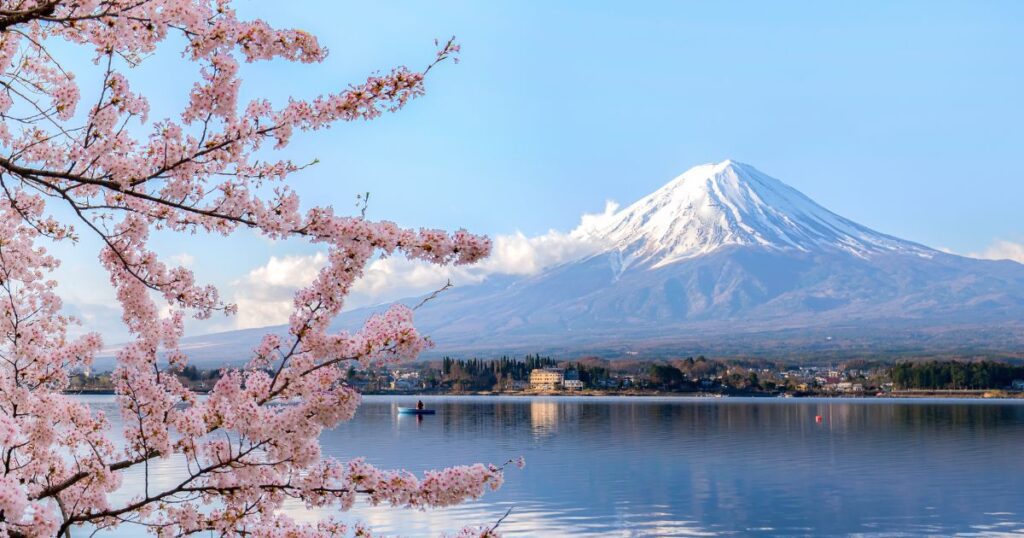Welcome to the breathtaking world of Mount Fuji, an active stratovolcano standing as Japan’s tallest peak at an imposing 3,776 meters. A UNESCO World Heritage Cultural Site and a revered symbol of Japan, Fujisan captivates hearts with its near-perfect symmetrical cone and a snow-capped crown that elegantly adorns it from late autumn to early spring. Visitors can go directly from Tokyo to Mount Fuji.
Table of Contents
1)The Allure of Mount Fuji:
The allure of Mount Fuji extends far beyond its natural beauty. As a traditional pilgrimage site, it invites thousands of hikers from July to August during the official climbing season. With well-trodden paths like the popular Yoshida Trail leading to the summit, it offers a spiritual journey as much as an adventurous climb. At its foot and around its lofty slopes, numerous Shinto Shrines quietly rest, further attesting to its spiritual significance.
Mount Fuji has four major trails that lead to the summit, each with its own unique characteristics:
a)Yoshida Trail:
As the most popular trail, the Yoshida Trail is often the first choice for many climbers. It has the most mountain huts, making it convenient for climbers planning to rest or stay overnight. It also separates into different paths for the ascent and descent, reducing congestion. The trail starts from Fuji Subaru Line 5th Station, and it’s particularly favored for those aiming to watch the sunrise from the summit, as it has great vantage points.
b) Subashiri Trail:
This trail is quieter than the Yoshida Trail, offering a more peaceful climb. It merges with the Yoshida Trail around the 8th Station. The descent route passes through a beautiful forest of Japanese red pine. Like the Yoshida Trail, it also begins from a 5th station, specifically the Subashiri 5th Station.
c) Gotemba Trail:
The Gotemba Trail is the longest and least steep of the four trails. It’s less crowded and has fewer mountain huts. The trail begins from Gotemba 5th Station and offers fantastic views, particularly during descent, as it passes through the largest volcanic sand desert known as Osunabashiri.
d) Fujinomiya Trail:
This trail is the shortest route to the summit and starts from Fujinomiya 5th Station, the highest of all the 5th stations. It is the only trail that offers a direct view of the Fujisan crater. It can get quite busy as it’s both the ascent and descent routes.
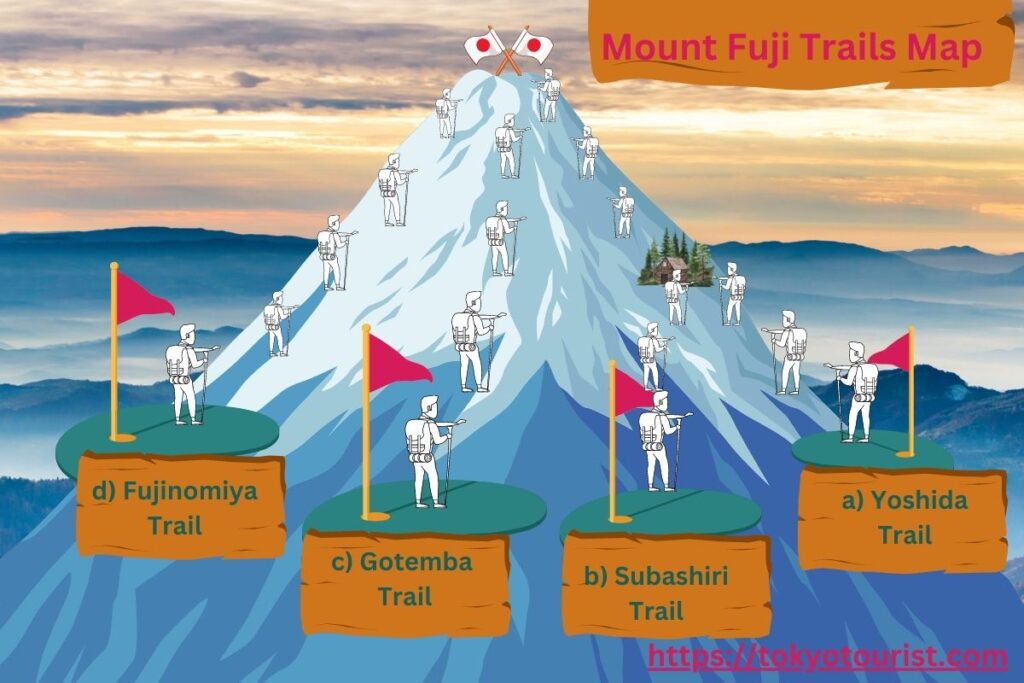
As to which is the best trail, it greatly depends on what you seek from your climb. If it’s your first time and you’re looking for a well-trodden path with many amenities, the Yoshida Trail would be a good choice. The Fujinomiya Trail is best to reach the summit quickly and see the crater up close. The Gotemba and Subashiri trails are better suited to experienced climbers seeking less crowded and more challenging routes.
Remember that climbing Mount Fuji is a serious endeavor and requires proper preparation, including physical fitness, suitable clothing and gear, and awareness of weather conditions. Planning your hike carefully and ensuring you are well-prepared to make the most of your adventure is advisable.
2) Exploring the Five Lakes of Fuji:
Basking in the mountain’s grand shadow are the Five Lakes of Fuji (Fujigoko), including Lake Kawaguchiko, Lake Yamanakako, Lake Saiko, Lake Shojiko, and Lake Motosuko. Each offering distinct views of the majestic mountain, these lakes are gateways to capturing Mount Fuji in its myriad moods. A particular favorite is the sight of Mount Fuji against the backdrop of blooming cherry blossoms – a quintessential image of Japan.
The Five Lakes of Fuji, collectively known as Fujigoko, are situated at the northern base of Mount Fuji in the Yamanashi Prefecture. The five lakes – Lake Kawaguchiko, Lake Yamanakako, Lake Saiko, Lake Shojiko, and Lake Motosuko – were formed hundreds of years ago by lava flows that dammed up rivers during Mount Fuji’s multiple eruptions. Each lake offers unique attractions and stunning views of Mount Fuji.
a) Lake Kawaguchiko:
Lake Kawaguchiko is the most popular for tourists as the most accessible of the five lakes and closest to Mount Fuji. It has the most developed infrastructure, with plenty of hotels, ryokans, restaurants, and museums.
It offers activities such as boat rentals and fishing, and you can explore the surrounding areas by bike or on foot. The lake’s northern shores provide a spectacular view of Mount Fuji, especially from the Kawaguchiko Ohashi Bridge.
Many tourist buses stop here on the way to Mount Fuji from Tokyo. These buses usually leave from Tokyo to Mount Fuji early in the morning.
b) Lake Yamanakako:
Yamanakako is the largest of the five lakes. Due to its relatively high altitude, it’s a popular escape from Tokyo’s summer heat. The lake offers many outdoor activities like windsurfing, fishing, and camping. It’s also known for its beautiful flower gardens, especially the Yamanakako Hananomiyako Park, which offers a stunning combination of colorful flowers with Mount Fuji in the background.
c) Lake Saiko:
Quieter than its neighbors, Lake Saiko is perfect for those seeking peace and tranquility. Wooded areas and campgrounds surround it, and you can rent boats for fishing or just relaxing on the water. You can explore the Aokigahara Jukai Forest and the Ice and Wind caves near Lake Saiko.
d) Lake Shojiko:
The smallest of the five lakes, Lake Shojiko, is less developed, which makes it a quiet and peaceful spot to enjoy nature. It offers arguably the most pristine views of Mount Fuji due to its lack of development.
e) Lake Motosuko:
Famous for being featured on the back of the 1000 yen bill and the “5 yen” coin, Lake Motosuko is renowned for its stunning views of Mount Fuji, especially during the Fuji Shibazakura Festival when the ground near the lake is covered in a dense carpet of pink moss.
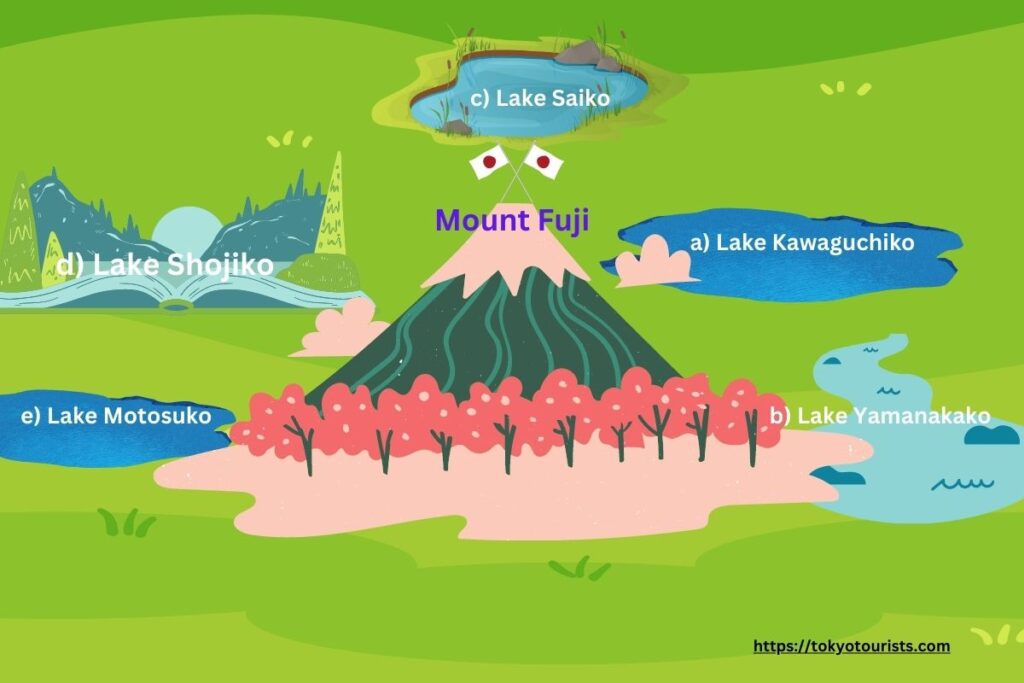
Of the five, Lake Kawaguchiko is the most convenient to access from Tokyo and offers the most amenities for tourists, making it an excellent base for exploring the Fuji area. However, each lake has its own unique charm and appeal, and what one might consider the “most beautiful” can depend largely on personal preference. It’s also quite feasible to visit multiple lakes in a single trip, as they’re all relatively close to one another.
3) Adventures Around Mount Fuji:
For thrill-seekers, Fuji-Q Highland amusement park at the mountain’s base offers a unique blend of adrenaline-pumping rides with incredible views. Those seeking tranquility can venture into the dense Aokigahara, also known as the Sea of Trees. Another unmissable spot is the Chureito Pagoda, a famous viewpoint that perfectly frames Mount Fuji, creating a picturesque scene that’s a dream for photographers.
Here are the details about these adventurous and scenic options around Mount Fuji:
a) Fuji-Q Highland:
This amusement park is famous for its thrilling roller coasters and theme-based rides. Located just at the base of Mount Fuji, offers a unique blend of fun and scenic beauty.
You can enjoy adrenaline-pumping rides like the “Fujiyama,” “Dodonpa,” “Eejanaika,” and “Takabisha,” which are among the world’s tallest, fastest, and steepest roller coasters.
Besides roller coasters, the park also features Thomas Land (a section dedicated to Thomas the Tank Engine and his friends) and attractions based on popular anime series. The backdrop of Mount Fuji adds an extra layer of excitement and offers fantastic photo opportunities.
In addition, it’s the most famous stop for visitors who come from Tokyo to Mount Fuji on a day trip.
b) Aokigahara:
Also known as the Sea of Trees, this dense forest situated at the northwest base of Mount Fuji is both serene and slightly eerie due to its quietness.
The Aokigahara Forest has several walking trails that lead to caves formed by lava from Mount Fuji’s eruption, including the Ice Cave and Wind Cave. Note that it’s important to stay on the designated paths, as it’s easy to get lost in this dense forest.
While it’s a place of natural beauty, be aware that it’s also known for its darker side as a place where people go to end their lives.
c) Chureito Pagoda:
Part of the Arakura Sengen Shrine, the Chureito Pagoda is a five-storied pagoda on a mountainside overlooking Fujiyoshida City and Mount Fuji. It’s become one of the most iconic views of Mount Fuji, particularly during the cherry blossom season in spring and the autumn leaf season.
You need to climb about 400 steps to reach the pagoda, but the breathtaking view at the top, featuring the pagoda with Mount Fuji in the background, is well worth the effort. This spot is a favorite among photographers, offering postcard-worthy shots in any season.
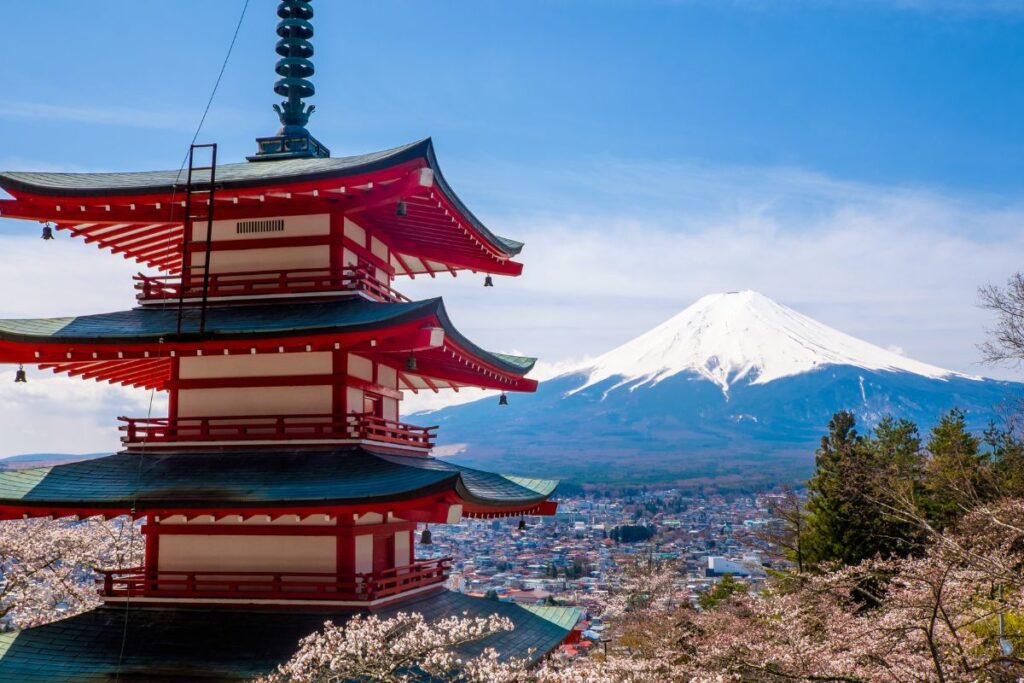
Each option offers a different way to experience Mount Fuji and the surrounding area, from thrilling rides to peaceful nature walks and unforgettable vistas.
4) Mount Fuji through the Seasons:
Mount Fuji wears different cloaks across seasons, each revealing a unique facet of its beauty. While the snow-capped brilliance of the mountain is a winter spectacle, the warmer months reveal the mountain in all its verdant glory. Spring graces Fujisan with the cherry blossoms bloom, and autumn adorns it with vibrant hues, making every season a great time to visit.
The best season to visit Mount Fuji largely depends on what kind of experience you’re seeking. Each season at Mount Fuji presents unique views and opportunities:
a) Spring (March to May):
Due to the blooming cherry blossoms, spring is one of the most popular times to visit Mount Fuji. The mountain provides a stunning backdrop to the vibrant pink and white cherry blossoms, creating an iconic and picturesque scene. The weather is generally mild, making it an excellent time for sightseeing and outdoor activities.
b) Summer (June to August):
The official climbing season for Mount Fuji is in summer, specifically from early July to early September. This is when the trails and mountain huts are open, and the weather conditions are relatively safe for climbing. The view of the sunrise from the summit, known as “Goraiko,” is a breathtaking sight that many climbers aspire to see.
c) Autumn (September to November):
Autumn is a fantastic time to visit if you enjoy vivid fall colors. The areas around Mount Fuji, including the Five Lakes region, are adorned in hues of red, orange, and gold, making for fantastic photo opportunities. The weather is also quite cool and comfortable.
d) Winter (December to February):
Winter provides a chance to see Mount Fuji with a stunning snow cap. The mountain is typically visible more often in winter due to the clearer weather. However, it’s worth noting that the climbing routes are closed due to hazardous conditions. Despite this, it’s an excellent season for photography, and you can enjoy winter sports in the nearby Fuji Five Lakes area.
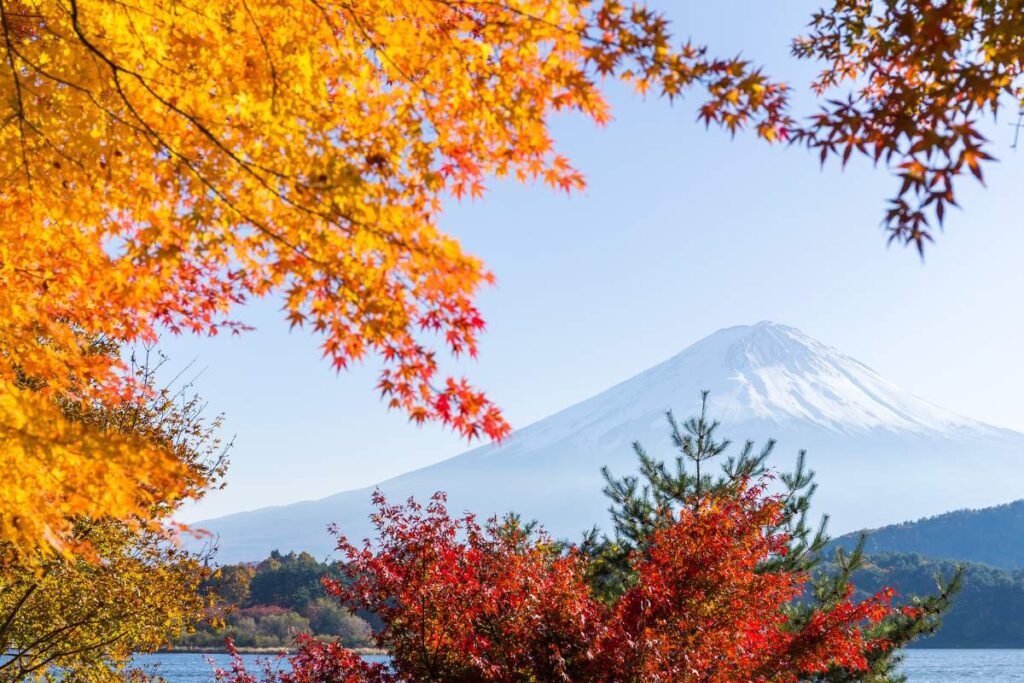
It’s important to remember that while Mount Fuji can be admired year-round from various locations in Japan, the visibility of the mountain largely depends on the weather, with the clearest views often seen early in the morning and in the late afternoon to evening. Clouds often obscure the mountain later in the day, especially in the warmer months. Therefore, flexibility in your travel schedule can increase your chances of getting a good view.
5)How to access Mount Fuji from Tokyo?
There are a few ways to access Mount Fuji from Tokyo, depending on your final destination around the mountain. Here are the main options:
By Bus:
From Shinjuku Station:
The easiest and most direct way to reach the Fuji Five Lakes area is by highway bus from the Shinjuku Expressway Bus Terminal in Tokyo. The journey to Lake Kawaguchiko takes about 2 hours. There are also direct buses to the 5th stations of the Yoshida and Fujinomiya Trails during the climbing season (July and August). Note that these buses may need to be booked in advance, especially during peak travel times.
Tokyo Station:
A more direct and often easier option is to take a highway bus from Tokyo Station. The JR Bus Kanto operates buses from Tokyo Station to Lake Kawaguchiko and Fujinomiya 5th Station. It’s a good option if you’re heading to the Fuji Five Lakes area, but remember to book your bus tickets in advance, especially during peak travel times.
If you’re looking to climb Mount Fuji, note that direct bus services are also available from Tokyo Station to the Kawaguchiko 5th Station on the Yoshida Trail during the climbing season (early July to early September).
By Train:
You can take the JR Tokaido Shinkansen (bullet train) from Tokyo Station to Shin-Fuji Station. However, this only works well if your final destination is the Fujinomiya 5th Station or the Fuji Five Lakes area.
The journey from Tokyo Station to Shin-Fuji Station via the JR Tokaido Shinkansen (bullet train) typically takes 1 hour to 1 hour and 10 minutes. However, from Shin-Fuji Station to Mount Fuji, you’ll need to take a bus or taxi to get to your final destination, which can add an additional 1 to 2 hours to your travel time, depending on traffic and your specific destination.
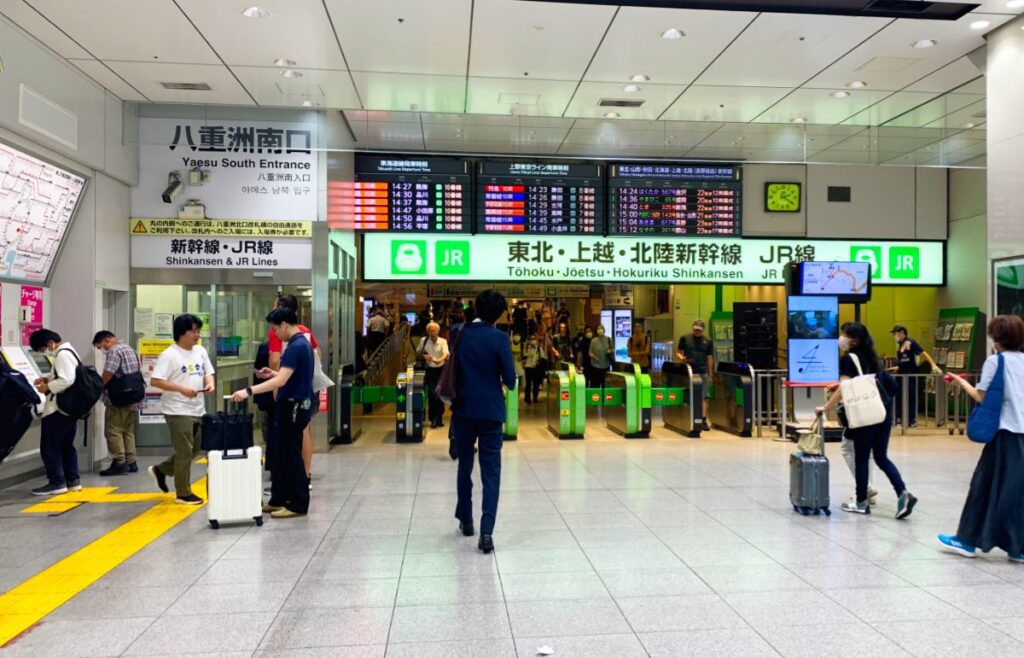
For example, if you’re heading to the Fujinomiya 5th Station, the bus journey from Shin-Fuji Station can take about 1.5 to 2 hours. If you’re heading to the Fuji Five Lakes area, it could take up to 2 hours or more by bus or taxi.
Therefore, the total travel time from Tokyo Station to Mount Fuji can range from approximately 2.5 to 3 hours or more, depending on your exact destination and the means of transportation you choose from Shin-Fuji Station.
Please remember that these times are estimates and can vary based on factors such as the time of day, the day of the week, the season, and traffic conditions. Always check the latest timetables and plan your journey accordingly.
Remember to check the schedules for buses and trains beforehand, and please remember that travel times may change depending on traffic conditions and other factors.
Feeling Confusion and thinking what’s the best option?
I have a good solution for you. Take one Day Bus Trip from Tokyo.
6) What’s the best option?
Many tourists ask what’s the best short-cut option to visit Mount Fuji. The answer is straightforward: taking a One Day Bus Trip.
One-day bus trips from Tokyo to Mount Fuji are a convenient and stress-free way to experience the majestic mountain and its surrounding attractions.
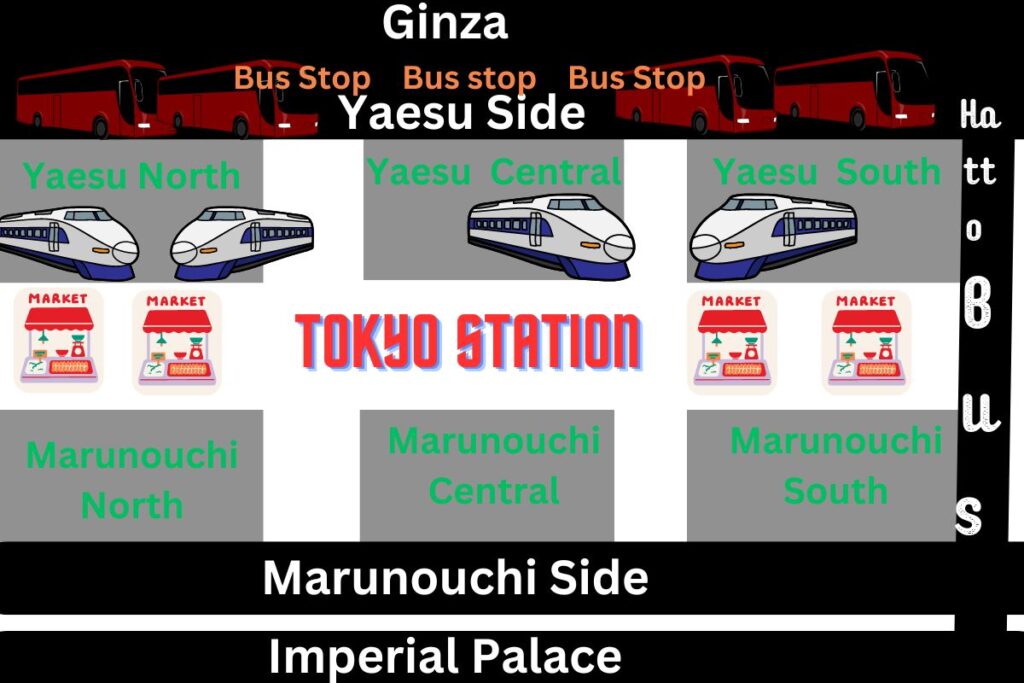
Here’s a popular itinerary that many tour companies follow:
1. Depart from Tokyo: The bus usually leaves from a central location like Shinjuku or Tokyo Station early in the morning. The journey to Mount Fuji takes about 2-3 hours, depending on traffic.
2. Visit Mount Fuji 5th Station: This is as high as you can go on Mount Fuji without hiking. Here you can enjoy panoramic views of the surrounding landscapes. The 5th Station also has souvenir shops and restaurants where you can enjoy delicious food admiring the beauty of Fuji.
3. Cruise on Lake Ashi: After visiting Mount Fuji, the tour typically proceeds to Hakone, an area known for its hot springs, traditional inns, and Lake Ashi. A boat cruise on this picturesque lake offers a different perspective of Mount Fuji, especially on a clear day.
4. Ride the Hakone Ropeway: Enjoy breathtaking views of Mount Fuji and Lake Ashi from above as you ride the ropeway between Sounzan and Togendai stations.
5. Return to Tokyo: The tour concludes with a bus ride back to Tokyo, typically arriving in the evening.
Many companies offer variations of this tour, and some include lunch or a visit to a hot spring. When selecting a tour, consider factors like the size of the group, language options, and included amenities. Also, remember that Mount Fuji’s visibility is highly dependent on the weather, and the mountain might not be fully visible on cloudy or rainy days. The best time for clear views is usually in the early morning or late afternoon, especially during the colder seasons.
Sound good?
You can check more photos and options about the One Day Bus Trip from Tokyo to Mount Fuji.
Enjoy Your Day:
Whether you’re an adventurer ready to conquer its heights, a spiritual seeker looking to embark on a pilgrimage, or a nature lover eager to capture its seasonal transformations, Mount Fuji awaits experiences as varied and profound as its landscapes. As you venture through the captivating region of Hakone or soak in an onsen with a view of the peak, you’ll leave with a piece of Fujisan’s magic etched into your heart.
Make sure to visit and embrace the majesty of Mount Fuji, an icon that stands not just as the highest peak in Japan but as an enduring symbol of the nation’s cultural and natural landscape.
A happy journey from Tokyo to Mount Fuji!!
Book Mt Fuji Tour:
